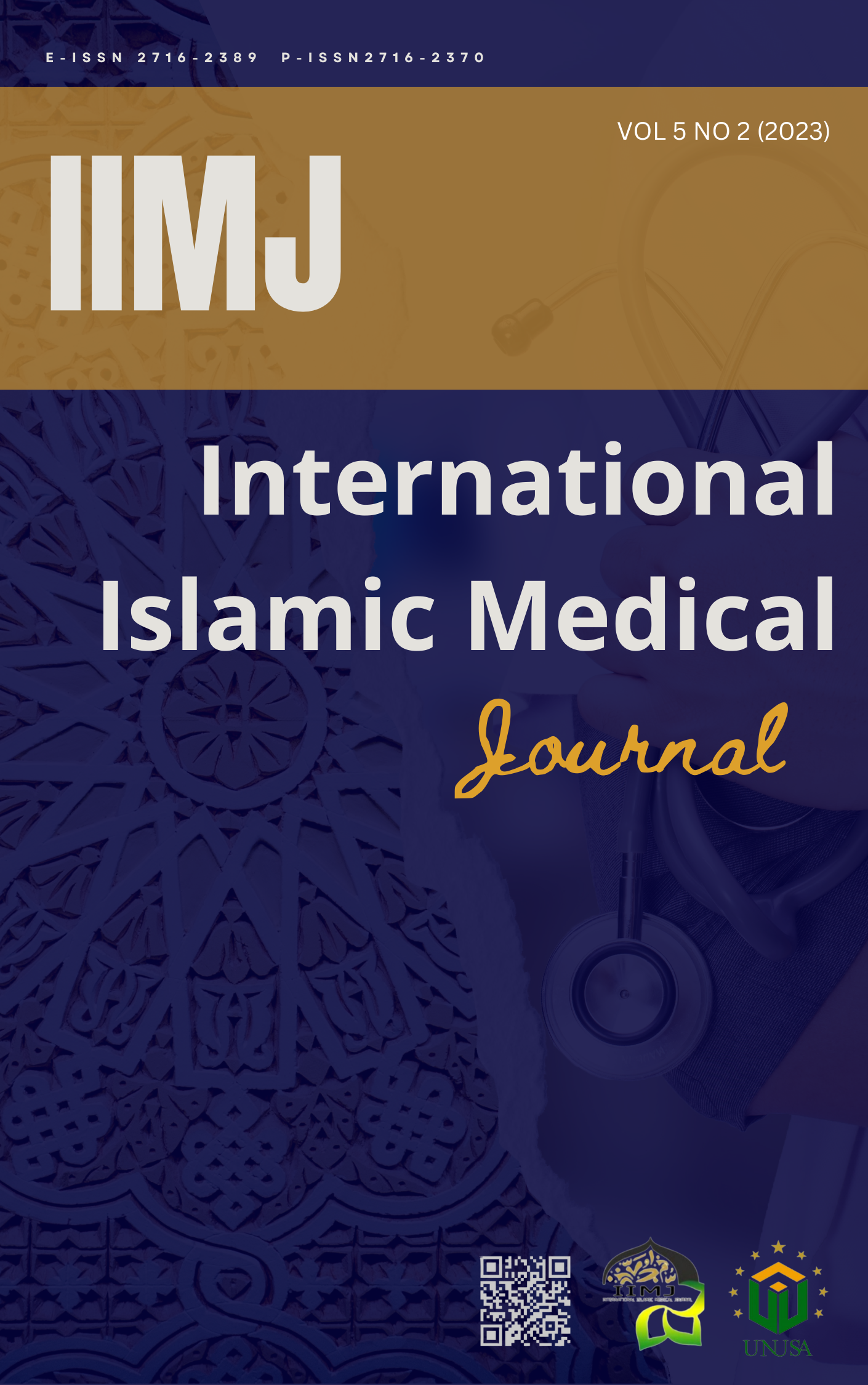Monitoring Pediculosis Capitis in Students At Al-Muhajirin Islamic Boarding School, Cikarang Pusat, West Java, Indonesia
Main Article Content
Abstract
Introduction : Pediculosis capitis is a scalp hair disorder caused by an infestation of the lice of Pediculus humanus capitis. The spread of this disease is dominant in Islamic boarding school students. This disease besides causing itching and lesions on the scalp also causes loss of concentration and enjoyment of learning in children. The objective of this study was to determine the percentage of female students infested with P. humanus capitis.
Methods : The design of this research is cross-sectional. The sample for this study was 41 female students of grade 7 at AL-Muhajirin Islamic Boarding School, Central Cikarang, West Java. Examination of P. humanus capitis on all female students was carried out using the serit method. The P. humanus capitis lice found were then collected and preserved preparations were made for microscopic morphological identification.
Results : The results of this study showed that from 41 samples, 36 (87.8%) students were found to be positive for P. humanus capitis.
Conclusions : The conclusion from this study is that the percentage of pediculosis capitis in female students is high, so it is necessary to take countermeasures in the form of head lice medication and education about personal hygiene for class 7 female students at Al-Muhajirin Islamic Boarding School, Central Cikarang, West Java
Downloads
Article Details
Copyright (c) 2024 Reza Anindita, Ega Nuraini Wahyu, Melania Perwitasari, Dede Dwi Nathalia, Maya Uzia Beandrade, Nofria Rizki Amalia Harahap

This work is licensed under a Creative Commons Attribution-ShareAlike 4.0 International License.
References
Adham, D., Moradi-Asl, E., Abazari, M., Saghafipour, A., & Alizadeh, P. (2020). Forecasting head lice (Pediculidae: Pediculus humanus capitis) infestation incidence hotspots based on spatial correlation analysis in Northwest Iran. Veterinary World, 13(1), 40–46. https://doi.org/10.14202/vetworld.2020.40-46 DOI: https://doi.org/10.14202/vetworld.2020.40-46
Analdi, V., & Santoso, I. D. (2021). Gambaran perilaku kebersihan diri terkait infestasi kutu kepala (Pediculus humanus capitis) pada santriwati di Pondok Pesantren Anshor Al-Sunnah Riau. Tarumanagara Medical Journal, 3(1), 175–181. https://doi.org/10.1016/j.fander.2021.04.004 DOI: https://doi.org/10.24912/tmj.v3i2.11760
Ary, W. B., Natalia, D., & Fitriangga, A. (2019). Gambaran dan Hubungan Karakteristik Individu dan Frekuensi Cuci Rambut dengan Kejadian Pediculosis capitis. Jurnal Cerebellum, 5(2), 1296–1306. https://jurnal.untan.ac.id/index.php/jfk/article/view/32926
Azim, F., & Andrini, N. (2018). Perbandingan Angka Kejadian Pedikulosis Kapitis antara Anak Laki-Laki dengan Anak Perempuan di Pondok Pesantren Al-Kautsar Al-Akbar Medan. Ibnu Sina Biomedika, 1(1), 72–79. http://www.tjyybjb.ac.cn/CN/article/downloadArticleFile.do?attachType=PDF&id=9987
Gumsah, A. S., & Apriani. (2021). Pedikulosis Pada Anak Di Wilayah Desa Babakan Asem Kecamatan Teluknaga. Jurnal Sehat Indonesia (JUSINDO), 3(02), 74–83. https://doi.org/Doi :10.36418/jsi.v3i2.30 74 DOI: https://doi.org/10.59141/jsi.v3i2.30
Hapsari, R. R. (2021). Pediculosis Capitis in Female Students’ Life At Pondok Pesantren PPAI An-Nahdliyah Kabupaten Malang. Media Gizi Kesmas, 10(1), 24. https://doi.org/10.20473/mgk.v10i1.2021.24-31 DOI: https://doi.org/10.20473/mgk.v10i1.2021.24-31
Kartashova, O. V, Lobuteva, L. A., Zakharova, O. V, Lobuteva, A. V, & Goykhman, A. A. (2019). Medical and Social Factors of Pediculosis. Journal of Medical Sciences, 7(19), 3240–3244.https://doi.org/https://doi.org/10.3889/oamjms. DOI: https://doi.org/10.3889/oamjms.2019.699
Khamaruddin, S., Daulay, W., Sukamti, S., & Suparni. (2020). Effect of Education on Behavior About Head Lice on Students In East Jakarta. Asian Journal of Applied Sciences, 8(2), 105–109. https://doi.org/10.24203/ajas.v8i2.6101 DOI: https://doi.org/10.24203/ajas.v8i2.6101
Lukman, N., Armiyanti, Y., & Agustina, D. (2015). Hubungan Faktor-Faktor Risiko Pediculosis Capitis Terhadap Kejadiannya Pada Santri di Pondok Pesantren Miftahul Ulum Kabupaten Jember. 27. http://repository.unej.ac.id/bitstream/handle/123456789/65672/AinulLatifah101810401034.pdf?sequence=1
Massie, M. A., Wahongan, G. J. P., & Pijoh, V. (2020). Prevalensi Infestasi Pediculus humanus capitis pada Anak Sekolah Dasar di Kecamatan Langowan Timur. Jurnal Biomedik, 12(1),24–30. https://doi.org/https://doi.org/10.35790/jbm.12.1.2020.26934
Mitriani, S., Rizona, F., & Ridwan, M. (2017). Hubungan Pengetahuan dan Sikap Tentang Pediculosis Capitis Dengan Perilaku Pencegahan Pediculosis Capitis pada Santri Asrama Pondok Pesantren Darussalam Muara Bungo. Jurnal Keperawatan Sriwijaya, 4(2), 26–36.
Nurcahyati, F. I., & Rangkuti, A. F. (2020). Analisis Tingkat Pengetahuan dan Personal Hygiene Dengan Kejadian Pediculosis Capitis di Pesantren Binaul Ummah Kabupaten Bantul. Dunia Keperawatan: Jurnal Keperawatan Dan Kesehatan, 8(3), 479. https://doi.org/10.20527/dk.v8i3.8088 DOI: https://doi.org/10.20527/dk.v8i3.8088
Nurdiani, U. C. (2020). Faktor-Faktor Yang Mempengaruhi Pediculosis Capitis Pada Anak-Anak Umur 6-12 tahun Di Pondok Pesantren Sirojan Mustaqim Dan Penduduk RW 03 Kelurahan Pondok Ranggon Kecamatan Cipayung Jakarta Timur. Jurnal Ilmiah Analis Kesehatan, 6(1), 39–48. https://doi.org/http://journal.thamrin.ac.id/index.php/anakes/issue/view/35 39 DOI: https://doi.org/10.37012/anakes.v6i1.354
Octavia, N. S., Wiryosoendjojo, K., & Nugroho, R. B. (2020). Hubungan Personal Hygiene Terhadap Kejadian Pediculosis capitis pada Santriwati Pondok Pesantren. Prosiding Setiabudi-CIHAMS, 15(4), 225–231. https://cihams.setiabudi.ac.id/index.php/proceeding
Pringgayuda, F., Putri, G. A., & Yulianto, A. (2021). Personal Hygiene Yang Buruk Meningkatkan Kejadian Pediculosis Capitis Pada Santri Santriwati Di Pondok Pesantren. Jurnal Keperawatan Muhammadiyah, 6(1), 54–59. https://doi.org/10.30651/jkm.v6i1.7235 DOI: https://doi.org/10.30651/jkm.v6i1.7235
Rohmaniah, S., & Prajayanti, D. E. (2022). Hubungan Pengetahuan dan Sikap Tentang Personal Hygiene pada Santriwati dengan Kejadian Pediculosis Capitis di Pondok Pesantren Al-Manshur Popongan. SEHATMAS: Jurnal Ilmiah Kesehatan Masyarakat, 1(4), 561–568. https://doi.org/10.55123/sehatmas.v1i4.915 DOI: https://doi.org/10.55123/sehatmas.v1i4.915
Sari, R. P., Handayani, D., Prasasty, G. D., Anwar, C., & Fatmawati. (2022). Hubungan Penggunaan Barang Bersama dengan Pedikulosis Kapitis pada Santri di Pondok Pesantren Subulussalam Palembang. Journal of Agromedicine and Medical Sciences, 8(2), 78–84. DOI: https://doi.org/10.19184/ams.v8i2.29113
Setiyani, E., Mulyowati, T., & Binugraheni, R. (2021). Hubungan Personal Higiene Dengan Kejadian Pediculosis Capitis Pada Santriwati Di Pondok Pesantren Rohmatul Qur ’ an Mejobo Kudus. Jurnal Labora Medika, 5, 35–38.
Setyoasih, A., & Suryani, D. (2006). Hubungan Antara Pengetahuan, Personal Hygiene, dan Infestasi Pediculus humanus var. capitis Pada Santriwati Muhammadiyah Boarding School Prambanan Sleman Yogyakarta. Jurnal Kedokteran Dan Kesehatan

